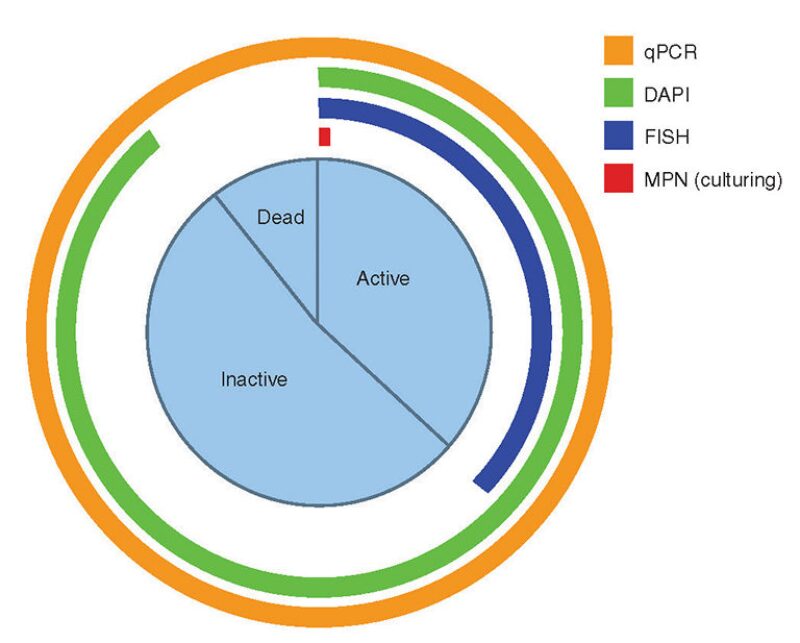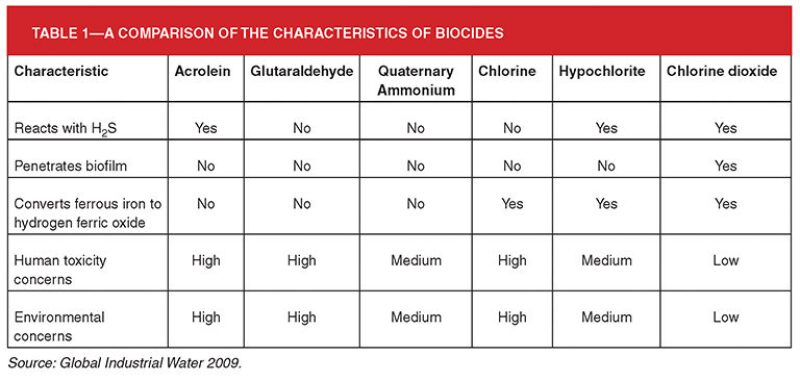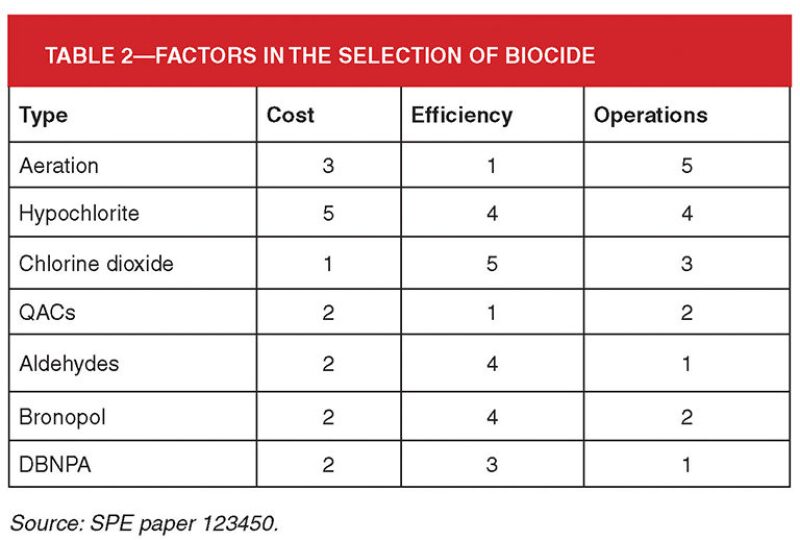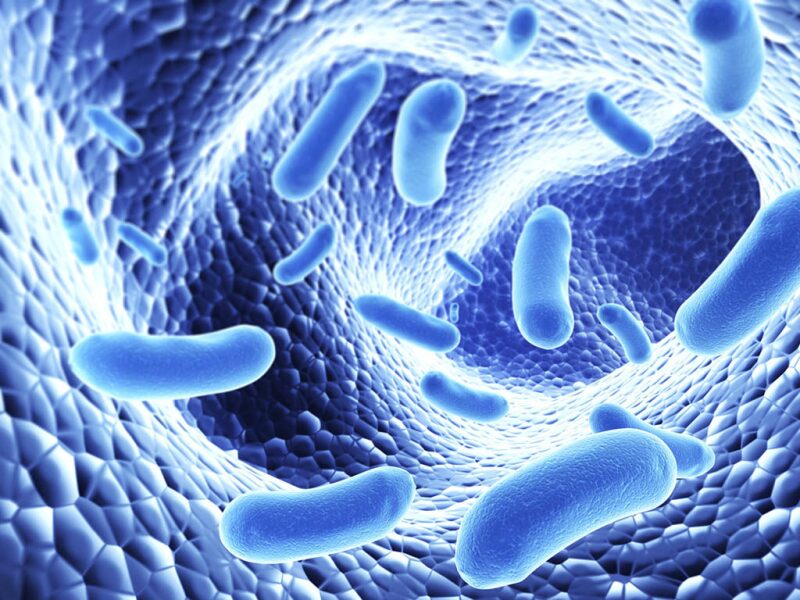This is the fifth article in a series covering water management in hydraulic fracturing in unconventional resources. In the first article, published in June 2013, water management and planning were discussed. Fluid properties and characterization were discussed in the second article, published in August. In the third article, published in October, suspended solids removal using coagulation/flocculation and electrocoagulation was discussed. This article discusses biological control.
The chemical formulations of hydraulic fracturing fluids include several additives. In previous articles, the polymeric friction reducers (slickwater, linear and cross-linked gel) were discussed. Those additives are typically present at high concentrations and have a dramatic effect on the ability to comply with water quality requirements for makeup and recycled water. Other additives include biocide, clay control, scale inhibitor, and flowback surfactant. The selection of the chemicals and their concentrations depends on the reservoir characteristics and the strategy for production stimulation.
Biocide application has been important in drilling and completion operations for as long as these operations have been practiced. Uncontrolled biological activity results in corrosion of the tubing, casing, and metallic well components. In severe cases, it can cause loss of casing integrity, which can result in loss of production and contamination of subsurface water aquifers. It can impair the near wellbore permeability, and thus reduce the productivity of the well.
Uncontrolled microbial activity has been responsible for near wellbore reservoir souring caused by the microbes’ production of hydrogen sulfide (H2S), which affected well and facilities integrity, the quality of the oil and gas, and the overall safety of operations.
In the application of unconventional hydraulic fracturing methods, biological control is important not only for the reasons already mentioned, but also to prevent souring of fracture water ponds. Souring of the ponds creates odor, which is unacceptable in populated areas and a safety risk for personnel working in the vicinity of the pond water.
Types of Microbes
The microbes that typically must be controlled with oilfield water treatment include the following:
- Acid-producing bacteria (APB)
- General heterotrophic bacteria (GHB)
- Sulfate-reducing bacteria (SRB)
- Sulfate-reducing archaea (SRA)
- Sulfate-reducing prokaryotes (SRP)—SRB and SRA occurring together
The APB are most closely associated with microbial-induced corrosion. The APB and the GHB are obligate aerobes, meaning that they require the presence of oxygen to grow. However, they do not necessarily die if oxygen is not available. They can become inactive for many years until oxygen is again available.
The other microbes are facultative anaerobes, meaning that they do not grow in the presence of oxygen. The aerobes grow much faster than the anaerobes. SRB and SRA (SRP) are responsible for generating H2S.
Biological Control Strategies
In the planning of biological control for drilling and completion fluids, assumptions are made. First, it is assumed that there are microbes present in any water source, whether it is obtained from surface water (river, lake, or municipality), the sea, or from a subsurface source, such as an aquifer well.
A reason for this assumption is the observed exponential growth rate of microbes. Even if there is only one microbe present per liter of source water, some hydraulic fracturing fluids will allow the microbial population to reach a million in just a couple of weeks.
The doubling time, the length of time required for one microbial cell to split into two cells, is an important variable in the population growth rate. For example, when a microbial community of 1,024 cells/L is present, the doubling time is the length of time required for the community to reach 2,048 cells/L.
Initially a microbial colony experiences a lag phase, during which it adapts to its environment. By chance, some of the microbes are more suited to the food type available, temperature, pH, and the chemistry of the water. Their cell mass will grow and they will begin to multiply. Gradually, the population of cells in the microbe colony will shift to those that are best suited for the environment.
Once the shift has occurred, exponential growth begins. Cell colony growth follows an exponential formula: 2n, where n is the number of doubling times. The shorter the doubling time, the faster the colony grows.
A short doubling time occurs in a favorable environment where nutrient concentration, temperature, pH, salinity, and water chemistry favor cell growth. The doubling time for Escherichia coli (E. coli) under ideal conditions is 20 minutes. In just over 4 hours, a single cell can become a million cells. Doubling times for SRB in seawater are about 6 hours.
Slickwater hydraulic fracturing formulations, particularly slickwater flowback fluids with high salinity, are typically not favorable to microbial growth. However, one of the features of guar-based hydraulic fracturing fluids is that the nutrient concentration is favorable for short doubling time.
Guar is essentially sugar. Other nutrients, such as nitrogen and phosphorous, are needed, but these are usually not limitations in microbial growth in guar. Doubling times for oilfield microbes in guar-based hydraulic fracturing fluid are not easily found in the literature. Based on experience, there is little doubt that such fluids provide environments favorable to microbial growth, which is a reason why chemical specialists try to achieve a “complete kill” of microbes at the start of the fracturing job.
Secondly, an assumption made in the selection of biocide chemical and dosage is that the success of the treatment will not be known accurately until it is too late to make adjustments. Many oilfield chemicals are applied at, or slightly above, the minimum required dose (MRD) to minimize cost and handling activities. However, determining the MRD for biocides is impractical for several reasons.
Most monitoring methods provide after-the-fact assessment. Also, some biocides are consumed by nonbiologic materials that may experience wide fluctuations in concentration. If a biofilm has developed, the dosage requirement to penetrate the biofilm may be higher than in cases where it is not present. While biocide chemical and dosage selection may be studied in the laboratory, it is customary to overdose in the field and confirm success some days or weeks after the application(s). Overkill is the typical practice.
Monitoring of Microbes
The methods used for detecting the presence of microbes and monitoring their concentrations in water have strengths and weaknesses, as discussed below (Richard 2012; NACE 2004).
Adenosine Triphosphate Photometry
Adenosine triphosphase (ATP) photometry is a rapid bacterial detection and counting method. It provides a measure of ATP, which is related, in some cases, to the total concentration of microbes, but it does not differentiate between microbe types. It can be carried out in the field and typically provides results in a few minutes. One of its drawbacks is that it detects the presence of ATP, whether the ATP is contained in an active cell, a dead cell, or has been expelled by a cell that has been lysed (burst open).
Most Probable Number
The most probable number (MPN) method, also known as the bacterial activity reaction test, is a culture media-based serial dilution method (Richard 2012). A sample of water is taken and added to a solution of culture media. The media containing the sample is placed in an oven. A subsample is taken from the first media bottle and placed into a second media bottle—providing a serial dilution. The sub-sampling is repeated; each sub-sample represents a dilution factor of 10.
After a certain number of days of growth in the culture medium, the samples are evaluated for the presence of microbes. Detection of GHB requires 2 days, APB requires from 7 to 10 days, and SRB requires 28 days. The different test times are due to the microbes’ different rates of growth.
The MPN method is capable of differentiating types of bacteria. In the case of SRB, the media contains dissolved iron, which combines with H2S to form black particles of iron sulfide. If the solution in the bottle has turned black, then it is concluded that SRB are present in the sample.
The drawbacks of the method are that a specific culture medium (solution) is used that may not be relevant to the actual water system being tested. The assumption is typically made that the culture medium is enriched and provides more nutrients than the actual water system. In the case of guar-based hydraulic fracturing fluids, this is probably not the case. Another drawback is that the results require extensive time to evaluate.
Molecular Microbiology Methods
Molecular biology tools are becoming more widely used in the oil and gas industry. Several methods that directly determine the concentration of cell components include the following:
- qPCR—quantitative polymerase chain reaction
- DAPI—detects the presence of DNA material
- FISH—fluorescent in-situ hybridization
Fig. 1 shows the fraction of active, inactive, and dead cells that are detected using the MPN and molecular biology methods. Because of the culture medium used, the MPN method detects only a fraction of the cells that are active. FISH is capable of generating a positive response for all active microbes. qPCR, like the ATP method, detects microbial materials, regardless of whether those materials are associated with intact cells.

Robinson et al. (2010) provide examples of the use of the molecular methods. Although the examples are for offshore platforms handling seawater, these same methods could be applied onshore for hydraulic fracturing operations.
Biocides Used in the Oil Field
Detailed information about the factors that should be considered when selecting a biocide for hydraulic fracturing applications are well-explained in SPE papers by Syfan et al. (2013), Dawson and Wood (2012), and Tischler et al. (2010).
Instead of repeating the information contained in the papers, some background with a slightly different perspective will be presented.
Typical biocides include the following:
- glutaraldehyde
- acrolein
- quaternary ammonium compounds (QACs)
- 2,2-dibromo-3-nitrilopropionamide (DBNPA)
- tetrakis (hydroxymethyl) phosponium sulfate (THPS)
- tetrahydro-3,5-dimethyl-1,3,5-triadiazine-2-thione (Dazomet)
- peracetic acid
- chlorine dioxide
- hypochlorite
- hypochlorous acid
The oxidizing biocides have limited persistence and are referred to as short-lived biocides (Syfan et al. 2013). These include chlorine dioxide, hypochlorite, peracetic acid, and ozone. The organic biocides, including DBNPA, THPS, glutaraldehyde, acrolein, and Dazomet, are more persistent. Table 1 compares the characteristics of biocides.

One of the characteristics of the biocides in Table 1 is the ability to penetrate biofilm. A biofilm is a microbial ecosystem that sessile microbes build to support a community of microbes. Sessile microbes are those that attach to the wall. In some cases, the biofilm is dense and the diffusion of large molecules is slow. This provides a natural defense against toxic chemicals. To be effective, a biocide must penetrate through the biofilm and kill the microbes present within the biofilm. Thus, the rate and extent of penetration is an important characteristic of a biocide.
Table 2 summarizes the factors to consider when selecting a biocide.

Overall, a high score is considered good. Cost, including the bulk cost of the chemical, transportation, mixing, capital equipment, and application, is ranked from 1 (high) to 5 (low). Efficiency is ranked 1 (low) to 5 (high). Operations are ranked by ease of handling, storage, and application, ranging from 1 (difficult) to 5 (easy).
Discussion of Biocides
Hypochlorite
Hypochlorite is a commonly used biocide in the oil and gas industry. It is used offshore for firewater systems and to prevent biological contamination of seawater waterflood systems. In offshore applications, hypochlorite is typically generated using an electrolytic generator. In onshore applications, it is transported in concentrated liquid form or generated on-site.
I am frequently asked about hypochlorite chemistry. Although there are several specialized references on the subject, there are few that discuss the general chemistry of both hypochlorite generators and liquid solutions. I have provided a summary below.
Hypochlorous acid (HClO) can be formed by adding chlorine to water, as shown in Reaction 1.

....(1)
The reaction typically favors the products. The resulting pH of the solution depends on how much chlorine gas is added, but at appreciable concentrations, the pH can be in the range of 3. When the resulting solution is added to produced water, it will reduce the pH. However, if the pH of the produced water is changed for some reason, the reaction will shift according to Le Chatelier’s principle. If, for example, more acid is added, the reaction will shift to the left and chlorine gas will evolve.
In practical oilfield applications, chlorine gas is hardly, if ever, used. Nevertheless, the above reaction helps to explain the chemistry and demonstrate that chlorine gas is generated by addition of acid to a solution of hypochlorous acid.
In addition to Reaction 1, the hypochlorous acid acts like an organic acid and partially dissociates in water to form the hypochlorite anion (ClO-1), as shown in Reaction 2.

.....(2)
The hypochlorous acid is a much stronger biocide than the hypochlorite anion. Thus, the term “hypochlorite” is a misnomer when referring to hypochlorous acid. Nevertheless, it is common terminology in the oil field and industrial and municipal water treatment fields.
The pKa (acid dissociation constant) of Reaction 2 is roughly 7.5, meaning that at a pH of 7.5, the molar concentration of hypochlorous acid equals that of hypochlorite anion. At a lower pH, there will be more hypochlorous acid than hypochlorite anion (Reaction 2 is shifted to the left).
For practical application, sodium hypochlorite (NaOCl) or calcium hypochlorite [Ca(OCl)2] are used. The calcium form is solid and is used as a swimming pool sanitizer. The sodium form is liquid and is commonly known as household bleach.
Solutions of sodium hypochlorite are manufactured by adding chlorine gas to a solution containing caustic, as shown in Reaction 3.
Almost all formulations of sodium hypochlorite for industrial or retail applications contain additional caustic, such that the pH is roughly 11. The high pH helps to prevent the release of chlorine gas.

.....(3)
When the solution of sodium hypochlorite and caustic is added to water, at typical dosage levels of less than 100 mg/L active chlorine, the pH of the water increases slightly due to the caustic in the solution. Typically, the bleach is added to water that has a slightly acidic or neutral pH. The pH of the treated water causes the equilibrium of Reaction 2 to shift in favor of the more active hypochlorous acid. Thus, the high pH of the manufactured product does not reduce the efficiency of the final application.
When hypochlorite is generated electrolytically, the following reactions occur. Chloride is oxidized at the anode (Reaction 4).

.....(4)
This reaction is followed rapidly by hydrolysis of the chlorine according to Reaction 1. Hydrogen is generated at the cathode. The reaction can be written in terms of sodium, calcium, or magnesium. Seawater contains abundant concentrations of these cations. Reaction 5 is written in terms of sodium


.....(5)
It is thought that the sodium anion is first reduced at the cathode and then rapidly hydrolyzed in water to form NaOH (aq) plus hydrogen (H2). Reaction 6 shows the net electrolysis reaction for the production of hypochlorite.

.....(6)
The Reaction 6 products are the hypochlorite anion, plus hydrogen. Once generated, the hypochlorite hydrolyzes according to Reaction 2, generating a hydroxyl anion, as shown in Reaction 7.

.....(7)
Reaction 7 establishes the equilibrium between the hypochlorous acid and the hypochlorite anion, as discussed for Reaction 2. The hypochlorous acid behaves as a weak organic acid in water. The equilibrium raises the pH, due to the generation of the hydroxide anion. The pH increase depends on the concentration of hypochlorite generated. Typically, the pH of seawater will increase one pH unit. In addition, the reaction generates hydrogen, which must be vented properly.
While this discussion of hypochlorite chemistry was more detailed than necessary for our purposes here, it is difficult to find a comprehensive discussion in the literature that is relevant to oilfield applications. As mentioned, I am asked about this regularly. Keeping track of which pH goes up and which goes down is a bit tedious. Hopefully, this discussion will help in your understanding.
Tetrakis (Hydroxymethyl) Phosponium Sulfate
Over the last 10 years, THPS has become one of the most widely used organic biocides in the oil and gas industry. It is a fast-acting, effective, and persistent biocide. There seems to be a decreased tendency for microbes to develop immunity or “superbug” strains in response to the application of THPS compared with the application of glutaraldehydes, in which this was a typical problem. THPS is also effective at scavenging iron sulfide.
Dawson and Wood (2012) discuss its use together with Dazomet. Together, THPS and Dazomet provide an effective and potent biocide combination that allows a reduction in the concentration used for treating hydraulic fracture water. This provides a cost advantage and reduces the likelihood of compatibility problems between the friction reducer and the biocide.
Chlorine Dioxide
Chlorine dioxide (ClO2) is an industrial water treatment technology that is suited to hydraulic fracturing application. I first became familiar with the industrial use of chlorine dioxide and its properties when I worked for a paper company early in my career. The paper industry uses it to bleach lignins, which are the dominant organic color-containing components of wood pulp. In that application, the chlorine dioxide breaks down the aromatic structure of lignins and thus, eliminates the color.
Chlorine dioxide is a powerful and selective biocide. It is not a general oxidizing agent. Its primary mechanism as a biocide is to oxidize aromatic groups, tertiary amines, and sulfide groups, making it selective for the amino acids that make up the enzymes and proteins of the microbes. It does not oxidize the wide range of organic compounds that are typically oxidized by chlorine and hypochlorite. Thus, less chlorine dioxide is required, and it is relatively nonreactive (except toward microbes). Since it is a small molecule, it is effective in penetrating biofilm.
Due to its specific reactivity with sulfide, chlorine dioxide is also useful in eliminating iron sulfide, which causes a wide range of problems in the oil field. Further, it has interesting reactivity with hydrogen sulfide (H2S). Once chlorine dioxide encounters biofilm, it breaks down the biofilm and forms chlorite (ClO3-1) as a reaction byproduct. Typically, H2S is present in a biofilm, having been generated by SRB. The chlorite reacts with H2S to form new chlorine dioxide inside the biofilm. This action/ reaction inside the biofilm makes chlorine dioxide extremely effective.
While chlorine dioxide is stable in a dilute aqueous solution, as a gas it is explosive. Thus, there is no practical way to transport concentrated solutions—it is generated on-site. Options for on-site generation include Global Industrial Water’s one-chemical method, for which it has built self-contained modular generating units.
In this method, sodium chlorite (NaClO2) is transported to a site. Handling sodium chlorite is safe, because it is a relatively nonreactive salt solution. In the modular generating unit, the chlorite is diluted and fed to an electrolytic cell. In the cell, the chlorite is reduced at the anode as shown in Reaction 8.

.....(8)
Electrolysis of water occurs at the cathode as shown in Reaction 9.

..... (9)
Reaction 10 shows the net electrolysis reaction for the production of chlorine dioxide.


.....(10)
An advantage of chlorine dioxide compared to hypochlorite is that it does not hydrolyze. Thus, the complicated reactions that are written above for hypochlorite do not occur with chorine dioxide. It can be used at lower concentrations with a higher level of efficacy. Since it does not hydrolyze, it is effective over a wide range of pH.
Other Approaches to Biological Control
Besides biocides, a number of waterflood operators inject nitrate (from 50 to 200 mg NO3–1/L of water). Nitrate stimulates the growth of nitrate reducing bacteria (NRB). Nitrate reduction produces a higher growth yield than sulfate. Thus, the NRB grow faster than the SRB. Since there is a limited availability of carbon, the growth of the NRB excludes the growth of the SRB, referred to as biocompetitive exclusion, and reduces the extent of reservoir souring. Nitrate is used extensively in waterflooding and has also been used in produced water treatment ponds on shore for oil fields and refineries.
The SRB oxidize carbon and reduce sulfate. There is a wide range of compounds that are suitable as carbon sources, such as guar (essentially sugar). Alkyl acids and alcohols are also suitable. In this reaction, the carbon source is oxidized to carbon dioxide and water, and the sulfate is reduced to H2S.
Ultraviolet radiation has been promoted as an effective and “green” answer to the microbial problem. However, there is widespread skepticism in the industry because water turbidity imparts a limitation to the effectiveness of the treatment. Simply stated, if a microbe is positioned behind a suspended particle, it will not be irradiated and thus, will not be killed.
Summary and Conclusions
Production chemistry of water treatment for hydraulic fracturing fluids is well-represented in the literature. The references below provide useful information, some of which was discussed in this column. Added insight, particularly about the inorganic biocides, has also been presented.
The October column mentioned that due to the importance of hydraulic fracturing, water treatment technologies, such as electrocoagulation, are making their way from industrial water treatment to the oil field. In biological treatment, an example is chlorine dioxide, which seems to be an effective biocide and has unique properties suitable for on-site generation and use.
For Further Reading
- SPE 123450 Controlling Bacteria in Recycled Production Water for Completion and Workover Operations by A. Tischler, Williams Production, et al.
- SPE 132697 Reservoir Souring in a Field with Sulphate Removal: A Case Study by K. Robinson, Oil Plus, et al.
- SPE 152051 A New Approach to Biocide Application Provides Improved Efficiency in Fracturing Fluids by J. Dawson, Frac Tech Services, and M. Wood, FTS International.
- SPE 166107 65 Years of Fracturing Experience: The Key to Better Productivity is Not What We Have Learned But What We Have Forgotten And Failed to Utilize by F.E. Syfan, GoFrac, et al.
- Global Industrial Water: Continuous-Dosage Chlorine Dioxide Treatment for Oilfield Waters, White Paper (September 2009).
- Hazardous Substance Fact Sheet: Chlorine Dioxide. 2005. New Jersey Department of Health and Senior Services.
- NACE TMO194-2004. Item No. 21224, Standard Testing Method: Field Monitoring of Bacterial Growth in Oil and Gas Systems. 2004. Houston, Texas: NACE International.
- Richard, J. 2012. Microbial Management to Improve OBW Discharge, H2O Injection, and H2O Reuse. Oral presentation given at the Produced Water Society Annual Conference.

John M. Walsh is the director of water treating technology at Cetco Energy Services and co-chairperson of the SPE Water Handling and Management Technical Section. He is a member of the Editorial Board of Oil and Gas Facilities. He can be reached at jmwalsh924@gmail.com.

